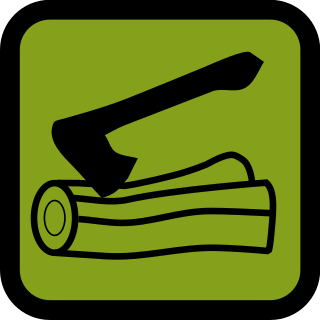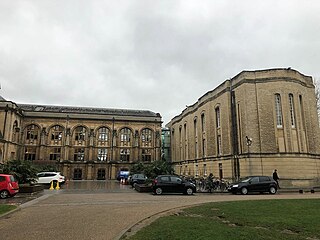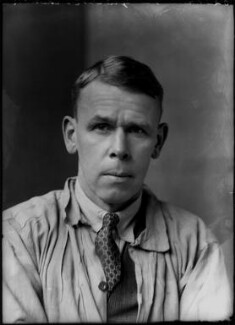
Lieutenant-General Robert Stephenson Smyth Baden-Powell, 1st Baron Baden-Powell, was a British Army officer, writer, founder and first Chief Scout of the world-wide Scout Movement, and founder, with his sister Agnes, of the world-wide Girl Guide/Girl Scout Movement. Baden-Powell authored the first editions of the seminal work Scouting for Boys, which was an inspiration for the Scout Movement.

Arthur Eric Rowton Gill was an English sculptor, letter cutter, typeface designer, and printmaker. Although the Oxford Dictionary of National Biography describes Gill as "the greatest artist-craftsman of the twentieth century: a letter-cutter and type designer of genius", he is also a figure of considerable controversy following the revelations of his sexual abuse of two of his daughters and of his pet dog.

The Radcliffe Camera is a building of the University of Oxford, England, designed by James Gibbs in a Baroque style and built in 1737–49 to house the Radcliffe Science Library. It is sited to the south of the Old Bodleian, north of the Church of St Mary the Virgin, and between Brasenose College to the west and All Souls College to the east. The Radcliffe Camera's circularity, its position in the heart of Oxford, and its separation from other buildings make it the focal point of the University of Oxford, and as such it is almost always included in shorthand visual representations of the university. The Radcliffe Camera is not open to the public.

The Bodleian Library is the main research library of the University of Oxford, and is one of the oldest libraries in Europe. It derives its name from its founder, Sir Thomas Bodley. With over 13 million printed items, it is the second-largest library in Britain after the British Library. Under the Legal Deposit Libraries Act 2003, it is one of six legal deposit libraries for works published in the United Kingdom, and under Irish law it is entitled to request a copy of each book published in the Republic of Ireland. Known to Oxford scholars as "Bodley" or "the Bod", it operates principally as a reference library and, in general, documents may not be removed from the reading rooms.

Brownsea Island is the largest of the islands in Poole Harbour in the county of Dorset, England. The island is owned by the National Trust with the northern half managed by the Dorset Wildlife Trust. Much of the island is open to the public and includes areas of woodland and heath with a wide variety of wildlife, together with cliff top views across Poole Harbour and the Isle of Purbeck.

Blandford Forum is a market town in Dorset, England, by the River Stour 13 miles northwest of Poole. It had a population of 10,355 at the 2021 census.

Gilwell Park is a camp site and activity centre in East London located in the Sewardstonebury area of Waltham Abbey, within Epping Forest, near the border with Chingford. The 109-acre (44 ha) site is owned by The Scout Association, is used by Scouting and Guiding groups. As the original base of leadership training in the Scout movement, it is an important site of the worldwide Scouting movement.

Durweston is a village and civil parish in the English county of Dorset. It lies two miles northwest of the town of Blandford Forum. It is sited by the River Stour at the point where it flows out of the Blackmore Vale through a steep, narrow gap between the Dorset Downs and Cranborne Chase. In the 2011 census the parish had a population of 398.

Bryanston School is a public school located next to the village of Bryanston, and near the town of Blandford Forum, in Dorset in South West England. It was founded in 1928. It occupies a palatial country house designed and built in 1889–94 by Richard Norman Shaw, the champion of a renewed academic tradition, for Viscount Portman, the owner of large tracts in the West End of London, in the early version of neo-Georgian style that Sir Edwin Lutyens called "Wrenaissance", to replace an earlier house, and is set in 400 acres (1.6 km2).

Pax Hill, near Bentley, Hampshire, England, was the family home of Robert Baden-Powell, founder of the Scout movement, and his wife, Olave, for over twenty years during the 20th century. It is located at the end of a half-mile drive, off the main A31 road.

The Radcliffe Science Library (RSL) is the main teaching and research science library at the University of Oxford in Oxford, England. Being officially part of the Bodleian Libraries, the library holds the Legal Deposit material for the sciences and is thus entitled to receive a copy of all British scientific publications.

Queen's Gate House, still commonly known by its previous name of Baden-Powell House, is a conference centre in South Kensington, London. It was built as a tribute to Lord Baden-Powell, the founder of Scouting, and has served as the headquarters for The Scout Association, as a hostel providing modern and affordable lodging for Scouts, Guides, their families and the general public staying in London and as a conference and event venue.

The Brownsea Island Scout camp was the site of a boys' camping event on Brownsea Island in Poole Harbour, southern England, organised by Lieutenant-General Baden-Powell to test his ideas for the book Scouting for Boys. Boys from different social backgrounds participated from 1 to 8 August 1907 in activities around camping, observation, woodcraft, chivalry, lifesaving and patriotism. The event is regarded as the origin of the worldwide Scout movement.

The British Boy Scouts and British Girl Scouts Association is an early scouting organisation, having begun as the Battersea Boy Scouts in 1908. The organisation was renamed as the British Boy Scouts and launched as a national organisation on 24 May 1909. In association with other Scout organisations, the BBS formed the National Peace Scouts in 1910. The BBS instigated the first international Scouting organisation, the Order of World Scouts in 1911.

Gilbert Ledward, was an English sculptor.
Fiona Leonora H. Peever, née Winkler, is a British sculptor based in Oxfordshire, England. With her husband and fellow-sculptor Alec Peever, she is a director of Lettering and Sculpture Limited, a sculpture studio. She carves in stone and other materials, and has produced public art, along with art for educational and religious institutions, besides private commissions. She is known for her sculpture of Thomas Attwood in Birmingham (1993), made in collaboration with Sioban Coppinger. This statue is unusual in that it appears to have stepped down from its soapbox to sit on the steps, seemingly reading some notes.

A statue of Robert Baden-Powell, founder of Scouting, is installed on the Quay in Poole harbour, Dorset on the south coast of England. The statue, erected in 2008, is a life-size bronze of Robert Baden-Powell by sculptor David Annand. It portrays Baden-Powell in his scout uniform, seated on a log as if for a campfire, with a pair of log seats either side which "allow easy access for photo opportunities".

The Statue of Robert Baden-Powell is a granite carving of Robert Baden-Powell, the founder of Scouting, at Baden-Powell House in Queen's Gate, South Kensington, London, England. The statue was created by the English sculptor Don Potter in 1960 and was installed and unveiled in 1961. It now stands in Gilwell Park, the home of Scouting, following the sale of Baden-Powell House in 2021.
Amy Eliza Krauss RWA was a British artist known for painting in oils and watercolours, and latterly ceramics. She is best known for the painting in the Royal Collection hanging in Queen Mary's Dolls' House at Windsor Castle and her close friendship with Frances Hodgkins.




















